tow BMW 330xi SEDAN 2002 E46 User Guide
[x] Cancel search | Manufacturer: BMW, Model Year: 2002, Model line: 330xi SEDAN, Model: BMW 330xi SEDAN 2002 E46Pages: 155, PDF Size: 2.24 MB
Page 107 of 155
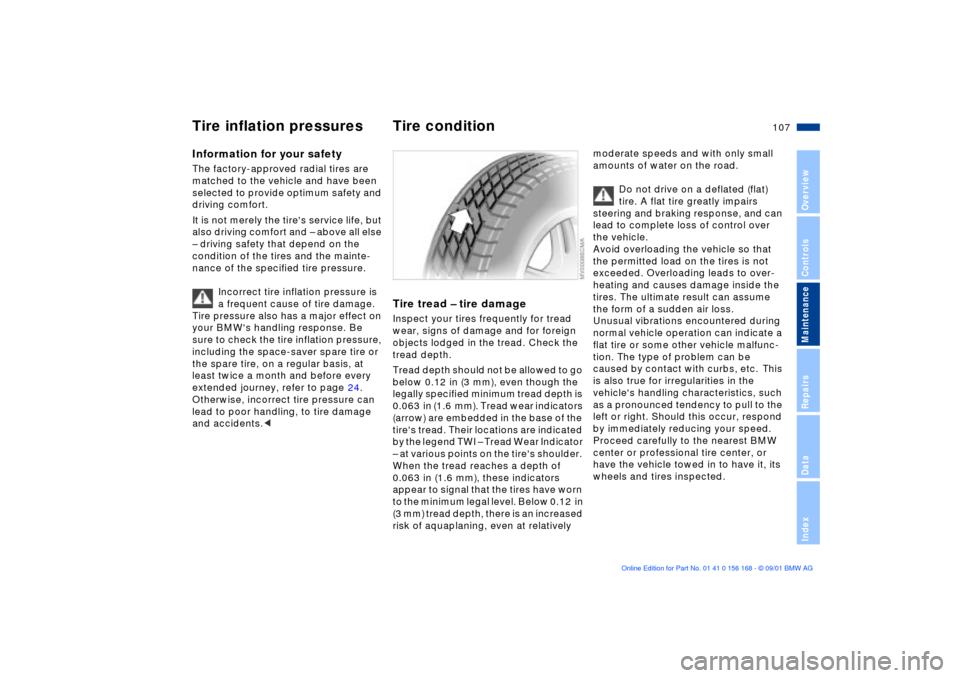
107n
OverviewControlsMaintenanceRepairsDataIndex
Information for your safetyThe factory-approved radial tires are
matched to the vehicle and have been
selected to provide optimum safety and
driving comfort.
It is not merely the tire's service life, but
also driving comfort and Ð above all else
Ð driving safety that depend on the
condition of the tires and the mainte-
nance of the specified tire pressure.
Incorrect tire inflation pressure is
a frequent cause of tire damage.
Tire pressure also has a major effect on
your BMW's handling response. Be
sure to check the tire inflation pressure,
including the space-saver spare tire or
the spare tire, on a regular basis, at
least twice a month and before every
extended journey, refer to page 24.
Otherwise, incorrect tire pressure can
lead to poor handling, to tire damage
and accidents.<
Tire tread Ð tire damageInspect your tires frequently for tread
wear, signs of damage and for foreign
objects lodged in the tread. Check the
tread depth.
Tread depth should not be allowed to go
below 0.12 in (3 mm), even though the
legally specified minimum tread depth is
0.063 in (1.6 mm). Tread wear indicators
(arrow) are embedded in the base of the
tire's tread. Their locations are indicated
by the legend TWI Ð Tread Wear Indicator
Ð at various points on the tire's shoulder.
When the tread reaches a depth of
0.063 in (1.6 mm), these indicators
appear to signal that the tires have worn
to the minimum legal level. Below 0.12 in
(3 mm) tread depth, there is an increased
risk of aquaplaning, even at relatively
moderate speeds and with only small
amounts of water on the road.
Do not drive on a deflated (flat)
tire. A flat tire greatly impairs
steering and braking response, and can
lead to complete loss of control over
the vehicle.
Avoid overloading the vehicle so that
the permitted load on the tires is not
exceeded. Overloading leads to over-
heating and causes damage inside the
tires. The ultimate result can assume
the form of a sudden air loss.
Unusual vibrations encountered during
normal vehicle operation can indicate a
flat tire or some other vehicle malfunc-
tion. The type of problem can be
caused by contact with curbs, etc. This
is also true for irregularities in the
vehicle's handling characteristics, such
as a pronounced tendency to pull to the
left or right. Should this occur, respond
by immediately reducing your speed.
Proceed carefully to the nearest BMW
center or professional tire center, or
have the vehicle towed in to have it, its
wheels and tires inspected.
Tire inflation pressures
Tire condition
Page 115 of 155
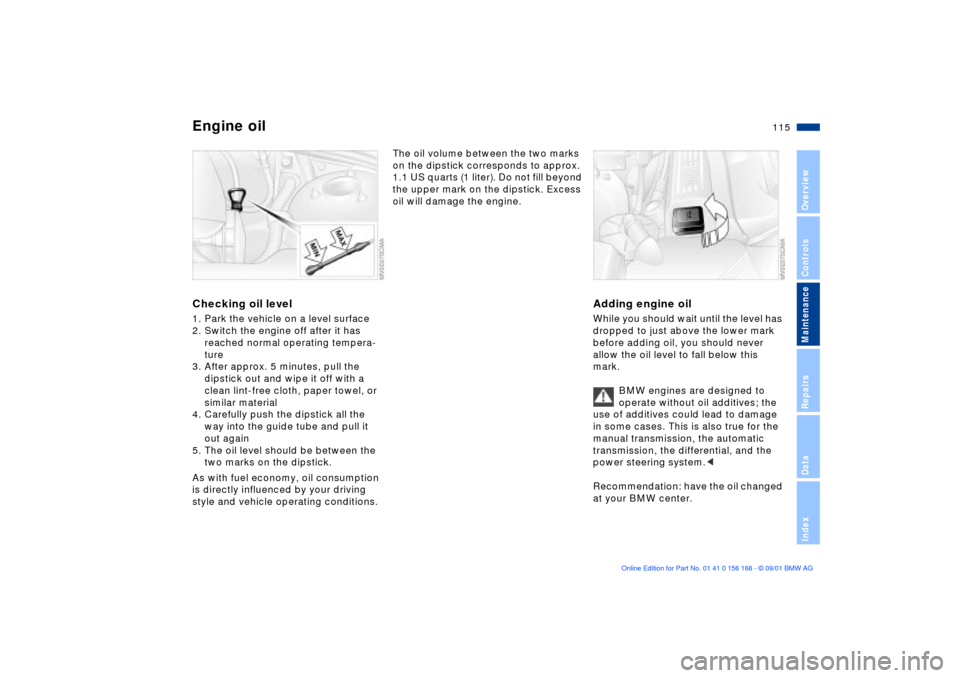
115n
OverviewControlsMaintenanceRepairsDataIndex
Engine oilChecking oil level1. Park the vehicle on a level surface
2. Switch the engine off after it has
reached normal operating tempera-
ture
3. After approx. 5 minutes, pull the
dipstick out and wipe it off with a
clean lint-free cloth, paper towel, or
similar material
4. Carefully push the dipstick all the
way into the guide tube and pull it
out again
5. The oil level should be between the
two marks on the dipstick.
As with fuel economy, oil consumption
is directly influenced by your driving
style and vehicle operating conditions.
The oil volume between the two marks
on the dipstick corresponds to approx.
1.1 US quarts (1 liter). Do not fill beyond
the upper mark on the dipstick. Excess
oil will damage the engine.
Adding engine oilWhile you should wait until the level has
dropped to just above the lower mark
before adding oil, you should never
allow the oil level to fall below this
mark.
BMW engines are designed to
operate without oil additives; the
use of additives could lead to damage
in some cases. This is also true for the
manual transmission, the automatic
transmission, the differential, and the
power steering system.<
Recommendation: have the oil changed
at your BMW center.
Page 124 of 155
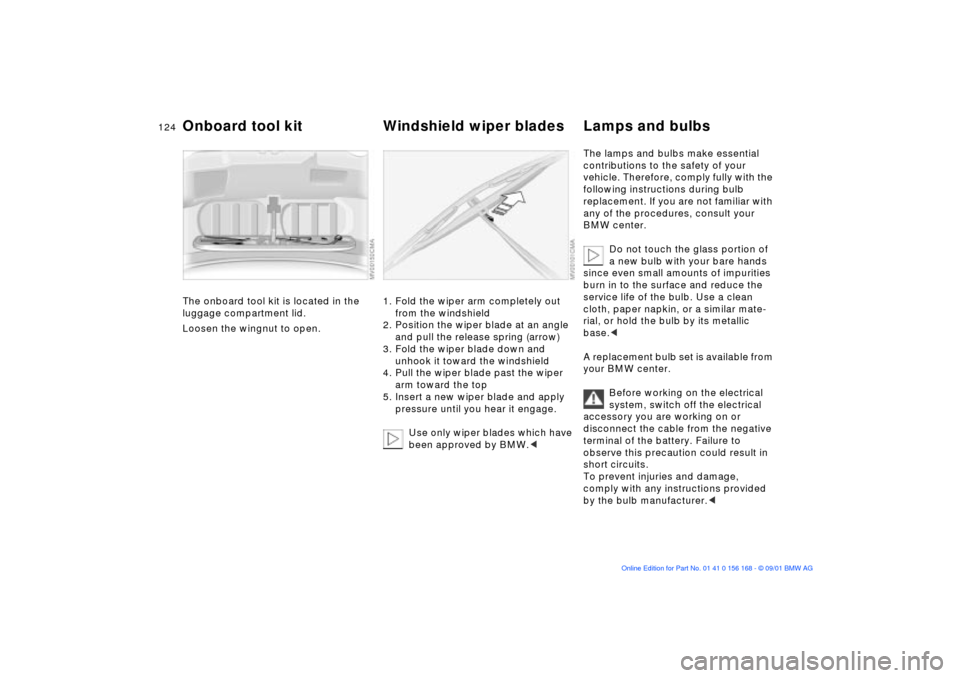
124n
The onboard tool kit is located in the
luggage compartment lid.
Loosen the wingnut to open.
1. Fold the wiper arm completely out
from the windshield
2. Position the wiper blade at an angle
and pull the release spring (arrow)
3. Fold the wiper blade down and
unhook it toward the windshield
4. Pull the wiper blade past the wiper
arm toward the top
5. Insert a new wiper blade and apply
pressure until you hear it engage.
Use only wiper blades which have
been approved by BMW.<
The lamps and bulbs make essential
contributions to the safety of your
vehicle. Therefore, comply fully with the
following instructions during bulb
replacement. If you are not familiar with
any of the procedures, consult your
BMW center.
Do not touch the glass portion of
a new bulb with your bare hands
since even small amounts of impurities
burn in to the surface and reduce the
service life of the bulb. Use a clean
cloth, paper napkin, or a similar mate-
rial, or hold the bulb by its metallic
base.<
A replacement bulb set is available from
your BMW center.
Before working on the electrical
system, switch off the electrical
accessory you are working on or
disconnect the cable from the negative
terminal of the battery. Failure to
observe this precaution could result in
short circuits.
To prevent injuries and damage,
comply with any instructions provided
by the bulb manufacturer.<
Onboard tool kit Windshield wiper blades Lamps and bulbs
Page 126 of 155
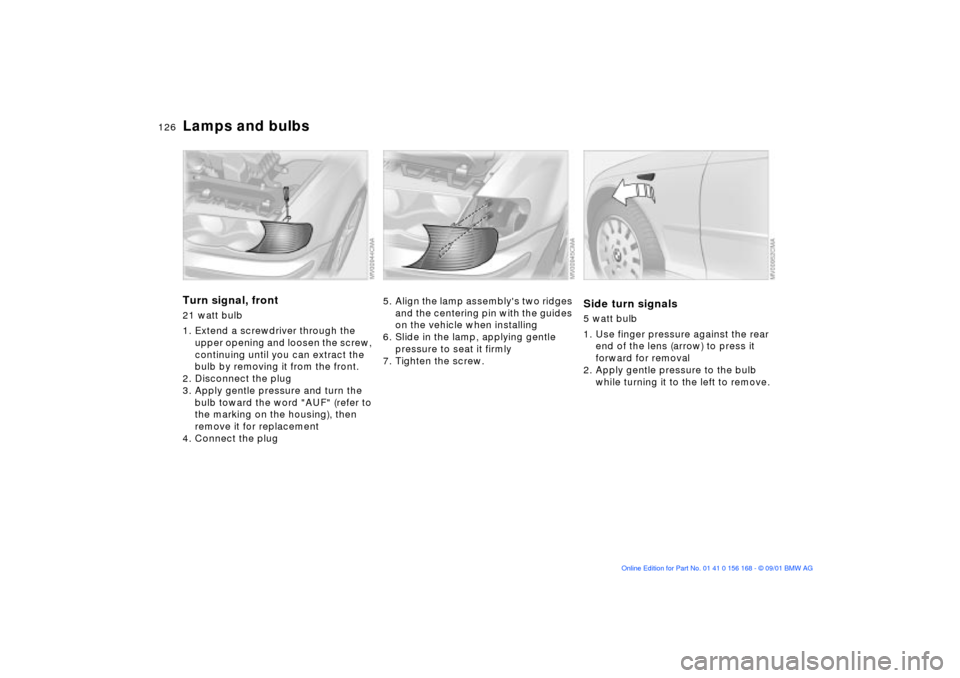
126n
Lamps and bulbsTurn signal, front 21 watt bulb
1. Extend a screwdriver through the
upper opening and loosen the screw,
continuing until you can extract the
bulb by removing it from the front.
2. Disconnect the plug
3. Apply gentle pressure and turn the
bulb toward the word "AUF" (refer to
the marking on the housing), then
remove it for replacement
4. Connect the plug
5. Align the lamp assembly's two ridges
and the centering pin with the guides
on the vehicle when installing
6. Slide in the lamp, applying gentle
pressure to seat it firmly
7. Tighten the screw.
Side turn signals5 watt bulb
1. Use finger pressure against the rear
end of the lens (arrow) to press it
forward for removal
2. Apply gentle pressure to the bulb
while turning it to the left to remove.
Page 128 of 155
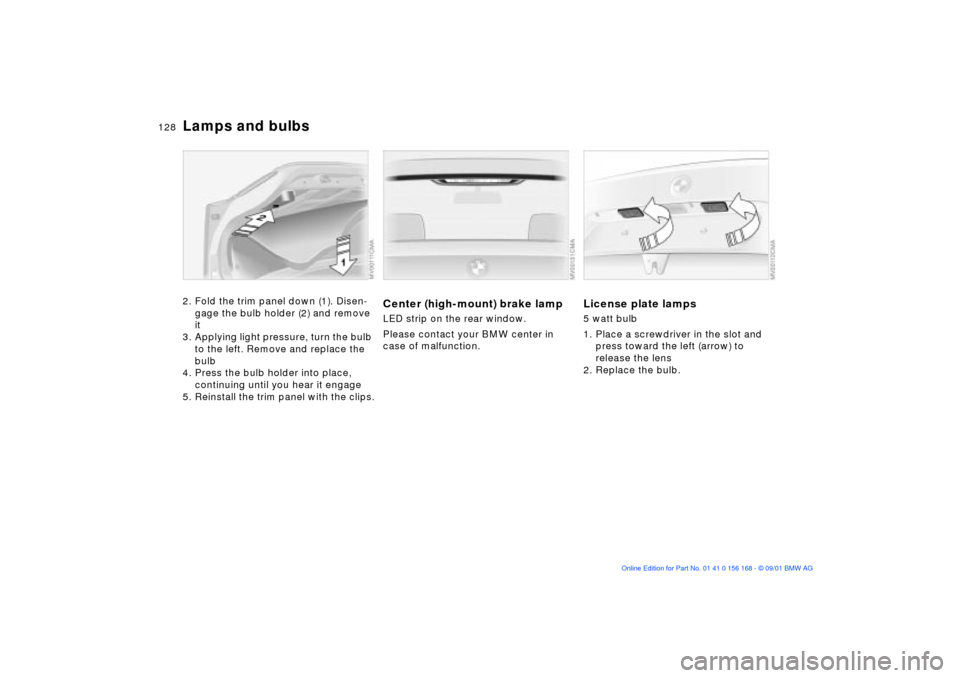
128n
Lamps and bulbs2. Fold the trim panel down (1). Disen-
gage the bulb holder (2) and remove
it
3. Applying light pressure, turn the bulb
to the left. Remove and replace the
bulb
4. Press the bulb holder into place,
continuing until you hear it engage
5. Reinstall the trim panel with the clips.
Center (high-mount) brake lampLED strip on the rear window.
Please contact your BMW center in
case of malfunction.
License plate lamps5 watt bulb
1. Place a screwdriver in the slot and
press toward the left (arrow) to
release the lens
2. Replace the bulb.
Page 135 of 155
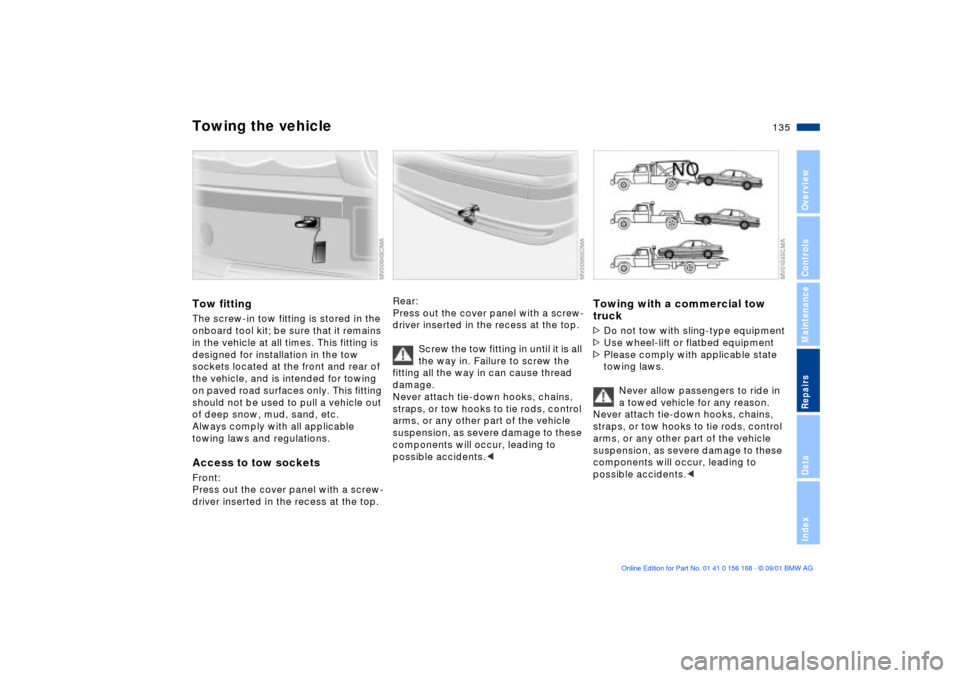
135n
OverviewControlsMaintenanceRepairsDataIndex
Towing the vehicleTow fittingThe screw-in tow fitting is stored in the
onboard tool kit; be sure that it remains
in the vehicle at all times. This fitting is
designed for installation in the tow
sockets located at the front and rear of
the vehicle, and is intended for towing
on paved road surfaces only. This fitting
should not be used to pull a vehicle out
of deep snow, mud, sand, etc.
Always comply with all applicable
towing laws and regulations.Access to tow socketsFront:
Press out the cover panel with a screw-
driver inserted in the recess at the top.
Rear:
Press out the cover panel with a screw-
driver inserted in the recess at the top.
Screw the tow fitting in until it is all
the way in. Failure to screw the
fitting all the way in can cause thread
damage.
Never attach tie-down hooks, chains,
straps, or tow hooks to tie rods, control
arms, or any other part of the vehicle
suspension, as severe damage to these
components will occur, leading to
possible accidents.<
Towing with a commercial tow
truck>Do not tow with sling-type equipment
>Use wheel-lift or flatbed equipment
>Please comply with applicable state
towing laws.
Never allow passengers to ride in
a towed vehicle for any reason.
Never attach tie-down hooks, chains,
straps, or tow hooks to tie rods, control
arms, or any other part of the vehicle
suspension, as severe damage to these
components will occur, leading to
possible accidents.c
Page 136 of 155

136n
Towing the vehicleBMW 325xi, 330xi: raise one of the
axles for towing1. Place the transmission in neutral
2. Switch off the engine
3. Maximum towing speed:
30 mph (50 km/h)
4. Maximum towing distance:
Max. 95 miles (150 km).
Before towing over a greater
distance: if towing with the front
axle raised, disconnect the rear drive
shaft; if towing with the rear of the
vehicle raised, disconnect the front
driveshaft. Failure to observe this
precaution will result in damage to the
transfer case.<
Page 148 of 155

Everything from A to ZDoor mirror48
Doors
electrical malfunction31
locking and unlocking29
manual operation31
DOT Quality Grades108
Draft-free ventilation87, 90
Drive belt17
defect17
Driving notes105
DSC (Dynamic Stability
Control)73
indicator lamp19
Dynamic Brake Control
(DBC)73, 74
Dynamic Stability Control
(DSC)73
indicator lamp19 E
Electric power windows37
Electrical malfunction
doors31
fuel filler door22
luggage compartment
lid33
sliding/tilt sunroof40 Elements of operation14
Emergency release of
luggage compartment lid
from luggage
compartment's interior35
Energy control66
Engine compartment
essentials113
Engine coolant, refer to
Coolant117
Engine data140
Engine oil
add115
capacity143
consumption115
level19
level, check115
level, indicator lamp17
pressure17
pressure, indicator
lamp17
Engine, starting56
Engine, switching off57
Exterior mirrors48
F
Failure messages68
Filling capacities143
Fittings, tow starting and
towing135
Flat tire132
Flat Tire
Monitor80, 109, 132
warning lamp17
Flat tires107, 129
Fog lamps83
Follow me home lamps82
Front seat adjustment41
Fuel consumption70
display67
Fuel filler door22
electrical malfunction22
manual operation22
Fuel gauge67
Fuel reserve indicator
lamp67
Fuel specifications23
Fuel tank capacity143
Fuel tank gauge67
Fuel-injection system140
Fuses133
G
Gasoline gauge67
Glove compartment92
Grilles88
Gross vehicle weight142 H
Handbrake58
Hands-free system94
Hazard warning triangle22
HDC (Hill Descent
Control)77
Head restraints44
Headlamp flasher61, 83
Headlamp washer
system114
Headlight control82
Headrests44
Heated seats47
Heavy cargo99
Height141
High beams20, 61, 83
bulb replacement125
Hill Descent Control
(HDC)77
Holder for canned
beverages93
Hood112
Horn14
Page 151 of 155
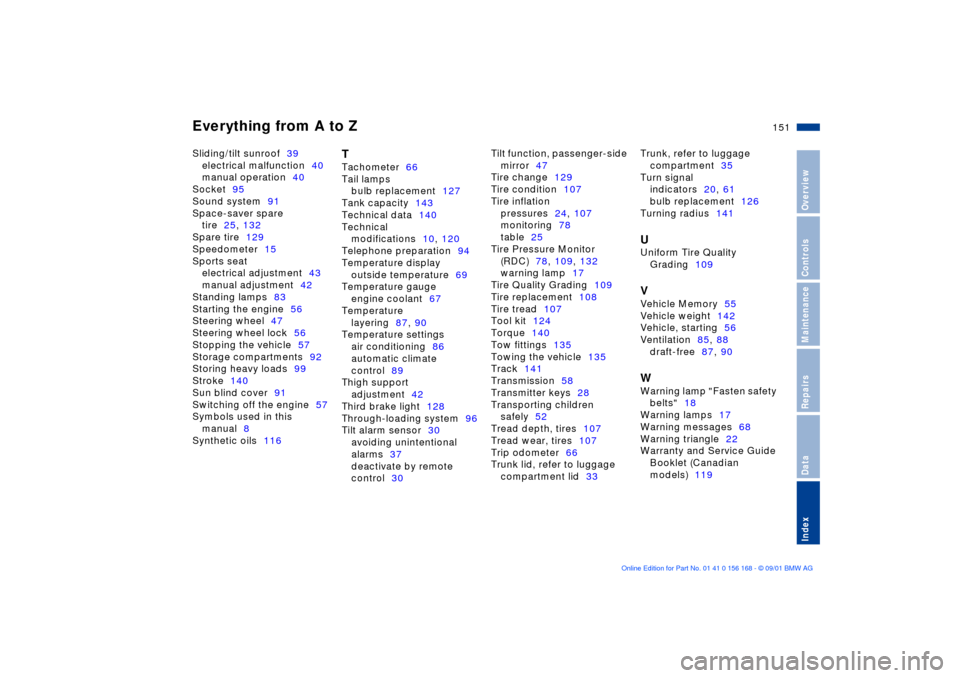
Everything from A to Z
151n
OverviewControlsMaintenanceRepairsDataIndex
Sliding/tilt sunroof39
electrical malfunction40
manual operation40
Socket95
Sound system91
Space-saver spare
tire25, 132
Spare tire129
Speedometer15
Sports seat
electrical adjustment43
manual adjustment42
Standing lamps83
Starting the engine56
Steering wheel47
Steering wheel lock56
Stopping the vehicle57
Storage compartments92
Storing heavy loads99
Stroke140
Sun blind cover91
Switching off the engine57
Symbols used in this
manual8
Synthetic oils116
T
Tachometer66
Tail lamps
bulb replacement127
Tank capacity143
Technical data140
Technical
modifications10, 120
Telephone preparation94
Temperature display
outside temperature69
Temperature gauge
engine coolant67
Temperature
layering87, 90
Temperature settings
air conditioning86
automatic climate
control89
Thigh support
adjustment42
Third brake light128
Through-loading system96
Tilt alarm sensor30
avoiding unintentional
alarms37
deactivate by remote
control30 Tilt function, passenger-side
mirror47
Tire change129
Tire condition107
Tire inflation
pressures24, 107
monitoring78
table25
Tire Pressure Monitor
(RDC)78, 109, 132
warning lamp17
Tire Quality Grading109
Tire replacement108
Tire tread107
Tool kit124
Torque140
Tow fittings135
Towing the vehicle135
Track141
Transmission58
Transmitter keys28
Transporting children
safely52
Tread depth, tires107
Tread wear, tires107
Trip odometer66
Trunk lid, refer to luggage
compartment lid33 Trunk, refer to luggage
compartment35
Turn signal
indicators20, 61
bulb replacement126
Turning radius141
U
Uniform Tire Quality
Grading109 V
Vehicle Memory55
Vehicle weight142
Vehicle, starting56
Ventilation85, 88
draft-free87, 90 W
Warning lamp "Fasten safety
belts"18
Warning lamps17
Warning messages68
Warning triangle22
Warranty and Service Guide
Booklet (Canadian
models)119